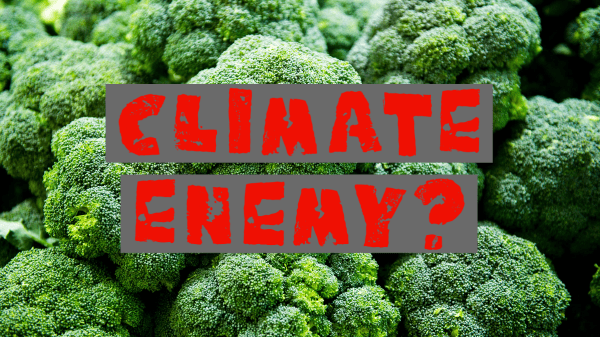I’m not sure what qualifications you need to be a columnist for a major newspaper. They can’t be rigorous ones.
Tamar Haspel, writing in the Washington Post, has assessed foods in regard to their effect on climate health.
Vegetables turn out badly.

“When you think of vegans and vegetarians, you naturally think of vegetables,” she writes. “Salads, leafy greens, broccoli, asparagus! And they’re all better climate choices than meat. But, among plants, they’re the worst choice.”
In the first place, she touts their chemical load, which for broccoli, according to her figures, is around $600 per acre. Versus $200 per acre for corn, $100 per acre for soybeans.
“Second is their perishability, which contributes to food waste,” writes Haspel. “Something like one-third of the food we grow in the United States gets wasted, but for fruits and vegetables, it’s closer to half. I’m betting that, if you were to check your fridge right now, you’d find something at the bottom of the crisper to prove the point.”
The third reason is the most peculiar: “In a world of overabundance, where obesity is a pressing public health problem, foods with few calories are a good thing. But when we have a growing population to feed, and limited land on which to do it, using that land to grow nutrients without calories is a luxury.”
Tree fruit and grapes fare better. Despite their use of pesticides, they do suck carbon out of the atmosphere.
The answer: “Staple crops—whole grains and legumes, but also tubers (potatoes and sweet potatoes) and even some starchy tree fruits (jackfruit and bananas)—are where the climate action is. They’re healthful, nutritious, versatile and much less perishable than garden-variety fruits and veg. They deliver calories and nutrition in one package. They use fewer inputs than other plants, and they’re often grown without irrigation.”
Her suggestion: turn that corn and soy into tortillas and tofu.
Whom is Haspel writing for? Becoming a “stapletarian” (her coinage) makes sense if you are struggling to get by on 1000 calories per day in sub-Saharan Africa (not that you would have much choice anyway).
But it is peculiar to make this recommendation to the affluent and educated readers of the Washington Post, who would for the most part do better to replace many of their starches with broccoli and leafy greens.
In a column I wrote earlier this year, I pointed out that George Orwell showed why stapletarianism isn’t likely to take off—even and especially for the poor.
Beware of the individual with only one idea.
Climate change—yes, a real concern, but to view everything simply through the lens of carbon-friendliness leads to shortsighted and bizarre conclusions. There are any number of other factors to consider, even when considering the implications of one’s own diet.
I find it extremely peculiar that Haspel does not even mention organic produce (or organic anything), which ought to be a major hero in her nutritional epic.
The produce industry—and indeed the food industry as a whole—is in one respect a victim of its own success. It has succeeded in feeding so many people with so few workers that average citizens have only a blurred view of what it takes to produce what they eat.
But food writers like Haspel really ought to have a more nuanced view of the subject they cover—and of their own audience.



